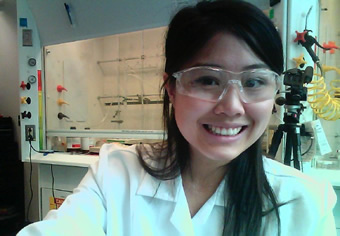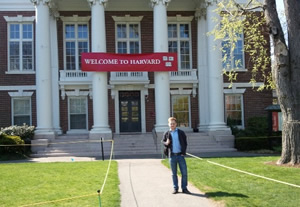- Co-ops called up to the Ivy League
- Celebrating the "HoneyBun" with a reunion
- Editor:
- Brandon Sweet
- Communications and Public Affairs
- bulletin@uwaterloo.ca
Co-ops called up to the Ivy League
Natalie Koay, 3B Science & Business, and Kevin Raymond, 2B Chemical Engineering, spent an incredible work term at Harvard’s School of Engineering and Applied Science, working on the science project of a lifetime.
 As assistants to grad student Ian Burgess, Natalie (right) and Kevin helped with the development of a sophisticated encryption device that has begun to garner major media attention. Ian, a Harvard PhD candidate and a graduate of Waterloo, is the mastermind behind the device, which could soon take off as the next great invention. The Wyss Institute-sponsored project, called Watermark-Ink, has been described as “James Bond meets Bill Nye the Science Guy.”
As assistants to grad student Ian Burgess, Natalie (right) and Kevin helped with the development of a sophisticated encryption device that has begun to garner major media attention. Ian, a Harvard PhD candidate and a graduate of Waterloo, is the mastermind behind the device, which could soon take off as the next great invention. The Wyss Institute-sponsored project, called Watermark-Ink, has been described as “James Bond meets Bill Nye the Science Guy.”
Watermark Ink or “W-Ink” is a chip that identifies the surface tension of a liquid – a property that accounts for whether drops of a liquid will bead up (if there is high surface tension) or flatten and spread (if there is low surface tension). The W-Ink chip, says Natalie, “is sort of like a litmus test to determine surface tension.”
What’s so great about that? Surface tension can be used as an identifying characteristic. Liquids will pass through the chip differently depending on whether they have a higher or lower surface tension- which means that designed properly, the chip can identify mystery solutions. Still don’t get it? Here’s an example. Natalie and Kevin programmed the chip so that it reveals the word “drink” when immersed in water. As they begin to add ethyl alcohol to the water, the message slowly changes, as if magically, from "drink" to "drunk."
Of course it’s no magic — just some sophisticated science. Ian and his team grow synthetic opals on the chip, full of honeycomb-like pores that shimmer and shine. Scientists like Ian can change the way liquids with different surface tensions will pass through these pores, causing the “structural colour” to disappear. By manipulating the pores accordingly, designs and messages can appear on the chip in response to a certain liquid.
It’s a tricky project to understand- even for a scientist. “There are a lot of different scientific concepts you need to draw from to get it,” says Natalie. “It took about a month for Kevin and I to get there.”
 Kevin (left) concurs: “One of the biggest challenges I faced during the term was just understanding the project,” he recalls. When the light dawned however, they were overcome with Ian’s infectious enthusiasm and passion. And who can blame them? Ian’s is one of the most interesting projects at the university-and full of potential. An identifying gadget like W-ink could have any number of applications. You could stick it in a cocktail to see how strong it is, or dip the chip in a mystery chemical spill to determine whether or not it’s hazardous. “It’s just really cool,” says Kevin.
Kevin (left) concurs: “One of the biggest challenges I faced during the term was just understanding the project,” he recalls. When the light dawned however, they were overcome with Ian’s infectious enthusiasm and passion. And who can blame them? Ian’s is one of the most interesting projects at the university-and full of potential. An identifying gadget like W-ink could have any number of applications. You could stick it in a cocktail to see how strong it is, or dip the chip in a mystery chemical spill to determine whether or not it’s hazardous. “It’s just really cool,” says Kevin.
They may be worldly and sophisticated scientists now, but for Kevin and Natalie taking the job at Harvard meant making a major transition. “The biggest fear that I had was inadequacy,” recalls Kevin. “I was thinking ‘What does Harvard want with me? What can I do for them?’” Even the surroundings were slightly overwhelming. “It was like Hogwarts!” laughs Kevin.
A great mentor soon made both Natalie and Kevin feel at home in the lab. “Ian and I had a lot in common in the interview,” recalls Natalie. “It was really easy to talk to him, so I thought that was a really good quality in a supervisor.” Once they got comfortable, there was no stopping this team. “Together, we became a collective unit that discussed a lot of the concepts,” says Natalie. “We were able to work well with each other.”
As the project continued to take off, so did Kevin and Natalie’s work term. They accompanied Ian to conferences, starred in news videos covering the W-ink project, and made contributions for the project’s second manuscript for a highly ranked scientific publication. Both say it was an honour to be directly involved in such a major project in the scientific community. “I got to experience an entire research life cycle,” says Natalie, “from working in the lab, to controlling something on a macro scale, to designing a product, to identifying marketing aspects for the future.”
“It was cool being able to contribute in a positive way to such an interesting project; a project that gained a lot of media attention,” says Kevin. He has returned to Harvard this term to continue work on the W-Ink project, along with five additional Waterloo co-op students – triple the amount hired in the lab last term.
Harvard is happy to have them. “Natalie and Kevin did an outstanding job this past summer working on the W-Ink project,” says Ian. “They have left a sufficient impression on our lab that my advisors will now be regularly hiring University of Waterloo co-ops.”
Celebrating the "HoneyBun" with a reunion
In August 1972, just before the start of fall classes, a new arrival was causing a stir in the Math & Computer building at University of Waterloo – a brand new Honeywell 6050 mainframe size computer running GCOS (General Comprehensive Operating Supervisor) and TSS (TimeSharing System). The arrival of this computer (which quickly got nicknamed “HoneyBun” and eventually “The ‘Bun”) set the stage for a whole new generation of computer innovators at University of Waterloo and was the foundation for many a computer and internet innovator.
To commemorate the HoneyBun, we've got a weekend of events planned from August 17-19, 2012, with a special gala celebratory dinner on the 18th.
To continue the stroll down memory lane, and for more reunion information, visit: http://randalljhoward.com/2012/07/16/bun-reunion/
Link of the day
Who knew what evil lurked in the hearts of men? The Shadow knew.
When and where
Examination period begins July 30, runs to August 10, 2012. Details.
Retirement celebration for David Mason, Tuesday, July 31, 3:30 p.m., Laurel Room, South Campus Hall.
All Retail Services locations closed August 6 for the Civic Holiday
Centre for Career Action workshop on law school applications, Thursday, August 9, 12:00 p.m., TC 1208.
UWRC Book Club, "The Sentimentalists" by Johanna Skibsrud, Wednesday, August 15, 12:00 p.m., LIB 407.
Mathematics Faculty HoneyBun Reunion, Saturday, August 18. Details.
CTE656 Getting Started in LEARN, session 0039, Tuesday, August 21, 10:00 a.m., FLEX Lab, LIB 329. Register through myHRinfo.
International Spouses event: "Singin' in the Rain" (with Gene Kelly)
Sunday, August 26 at 1:00 p.m. Must pre-register. See website for details. http://intlspouses.wordpress. com/next_meeting/
Fall 2012 Promissory Notes and payments are due August 27.
CTE656 Getting Started in LEARN, session 0040, Wednesday, August 29, 1:00 p.m., FLEX Lab, LIB 329. Register through myHRinfo.